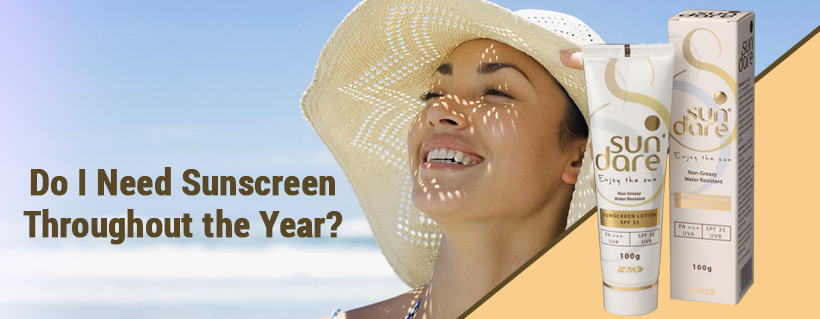Menu

Date: 6th. April,2017
It’s a common perception that sunscreen should be worn only when it’s sunny outside. But the sun shines in all seasons and UVA and UVB radiations can cause damage whether its sunny or not. Even on a completely cloudy day, up to 40% of UV rays can reach us.
In a tropical country like India, we receive ample sunlight throughout the year. Excessive exposure to sunlight can cause sunburns, wrinkles, pigmentation, premature ageing, and even cancer. A sunscreen protects you from sun’s UV rays. So, if it’s daytime, you need to wear sunscreen regardless of the season.
What is SPF and Why Does It Matter?
Anyone who has ever bought a sunscreen is sure to have come across the term, ‘SPF’. SPF stands for ‘Sun Protection Factor’. It is a measure of how well your sunscreen protects your skin from UVB rays. SPF is directly proportional to the protection a sunscreen offers. SPF 15 and above are optimal for protection.
In terms of percentage, SPF 15 filters out about 93%, SPF 30, 97% and SPF 50, 98% of UVB rays. You can select the right SPF value for you depending on the sensitivity of your skin and the number of hours you spend outdoors.
However, SPF only takes care of UVB rays so make sure you buy a sunscreen that offers protection from both UVA and UVB rays.
8 Sunscreen Application Tips:
1. All exposed areas should be lathered with sunscreen. This includes your face, arms, ears, nose, back of the knees, legs, and especially the back of your neck.
2. If you plan to stay outdoors for a long duration, use a water-resistant sunscreen so it doesn’t get washed away with sweat.
3. Apply the sunscreen 15-30 minutes before going out in the sun. This helps your skin to absorb the lotion and makes the sunscreen’s effects last much longer.
4. Reapply the sunscreen after every 20 minutes, once the exposure starts. Many health agencies recommend doing so after 2-3 hours but this practice will lead to a UV exposure of 60-80%.
5. If you plan on applying makeup, make sure you apply the sunscreen lotion first.
6. Lips need more protection as they don’t produce enough melanin to protect themselves from the sun. So, ensure that your lip care product contains high sun protection too.
Choosing Sunscreen as per Skin Type
When it comes to sunscreens, one size doesn’t fit all. Not all skin types are the same and neither are all sunscreens.
As mentioned above, sunscreens are important for protection from sun’s harmful UV rays throughout the year. However, they are not foolproof. The quantity of sunscreen applied is just as important as the quality. For comprehensive sun protection, physical barriers like sunglasses, broad-brimmed hats, and full clothing should be used as well.
References:


| PRODUCTS | QTY | PRICE | VALUE in INR |
|---|
| PRODUCTS | QTY | PRICE | VALUE in INR |
|---|